Cast your eyes from the battlements of Stirling Castle and you could be looking at a map of Scottish history. To the east, fields and hills that witnessed William Wallace’s most famous victory. To the south, the rolling hills where Robert the Bruce led his men to a nation’s destiny. And right under your feet? A wealth of stone walls that have witnessed coronations and sieges, royal scandals, and the footsteps of more ghosts than you can shake a stick at.
If you thought the castles in Scotland couldn’t get any cooler than Edinburgh, or any bigger than Glasgow, you haven’t yet seen Stirling. Nestled high on a volcanic crag, the site isn’t just a site. It’s the stage where the real history of Scotland was set. Scotland’s most desired royal seat, a jewel of the Renaissance in the north, a fortress whose position gave it the reputation “He who holds Stirling, holds Scotland.”
It’s a chance to take a step back in time to a place where the past is closer than you think. An opportunity to walk the Great Hall where kings once feasted, marvel at the carved “Stirling Heads” that stare down from the ceiling, or just lean on the stone parapet and take in the same views that have inspired and petrified generations of Scots.

Stirling Castle Quick Facts
📍 Location: Stirling, Scotland
🏗️ Construction Period: 12th–18th century
🏰 Architectural Style: Renaissance with Medieval fortifications
🎭 Famous For: Royal coronations, key battles, Renaissance artistry
👑 Notable Figures: Mary, Queen of Scots; James IV; James V; Robert the Bruce
🏆 UNESCO Status: Not listed, but a candidate in Scotland’s tentative heritage register
🌐 Official Website: Stirling Castle – Historic Environment Scotland

History & Legends

A Fortress on a Crag
High above the flat land of central Scotland, the craggy bulk of Stirling is not a product of human ingenuity, but a gift from nature. Formed 350 million years ago by volcanic activity, this ‘volcanic plug’ juts 130 metres out of the earth. From the top of the castle, you can see for miles in every direction; to the north and west, across the plains to the Highlands; to the east, across the rolling Ochil Hills, and down to the serpentine River Forth, glittering in the sun like a silver ribbon. In military terms, Stirling’s position is excellent. Whoever controlled the castle controlled the central artery that ran between north and south, Highland and Lowland. There is evidence that the site was a fortification from the early medieval period. By the 12th century, we have documentary evidence of a royal castle on Stirling Rock, which would have stood as both an assertion of authority and a guardian over the heart of the Scottish kingdom.
The Wars of Independence
Many of the castle’s most dramatic episodes come in the late 13th and early 14th centuries, during the Wars of Independence. In 1297, William Wallace and Andrew Moray led a smaller Scottish army to a resounding victory against English forces at the Battle of Stirling Bridge, only a few miles from the castle. Over the next few years, the site changed hands several times, often as the result of a siege or treachery.
The most famous military action of the castle’s history is probably indirectly related to Stirling Bridge. In 1314, the English garrison inside Stirling Castle was under siege, and the question of whether they would surrender or hold out determined the Battle of Bannockburn – one of Scotland’s most famous victories. It was from Stirling Castle’s battlements that people gazed out across to the fields where Robert the Bruce’s army broke the English lines. From here, the Scottish troops marched to victory, a crucial step towards securing Scotland’s independence.
From Fortress to Palace
By the 15th century, Scotland’s kings saw Stirling Rock as more than just a military prize. James IV of Scotland recognised the site’s potential to serve as a seat of royal splendour and majesty. In particular, he commissioned the Great Hall, 42 metres long, with a hammer-beam roof stretching high overhead, all designed to impress foreign ambassadors and awe his Scottish court. This was the place for great banquets, with the sound of music, the clatter of trenchers and flagons, the whisper of silk, and the flash of candlelight against gold and red velvet tapestries.
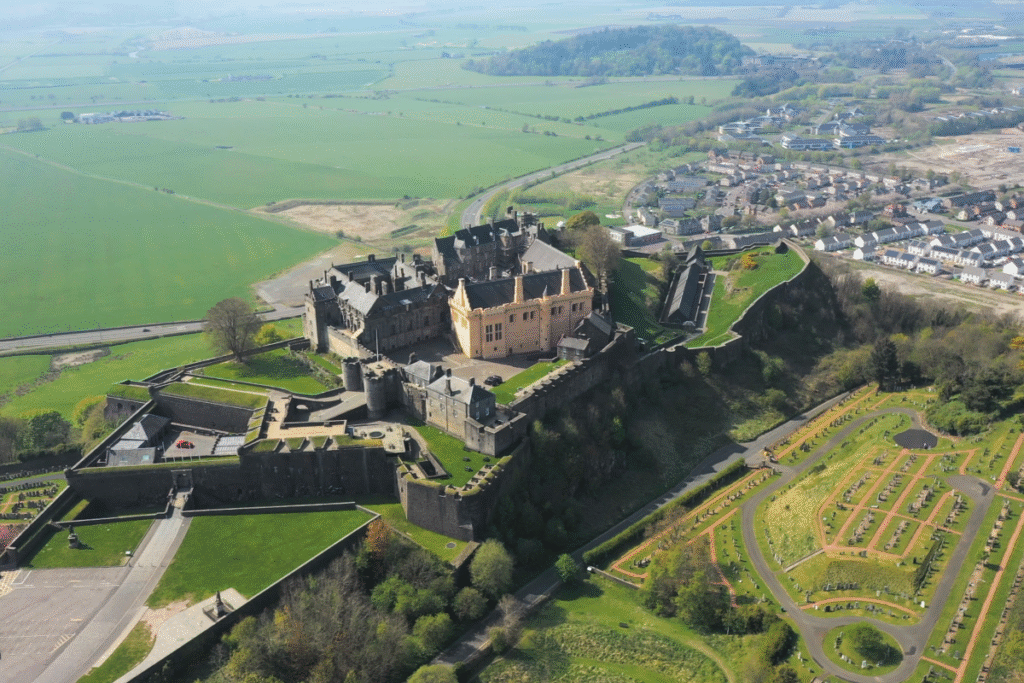
The hall was the work of James IV, but his son, James V, was responsible for the real transformation of Stirling into a Renaissance palace. He built the Royal Palace, which stood until its demolition in the 17th century. Renaissance styles had come to Scotland through James’s visits to France, and he had European craftsmen come to work on the building. Its carved façades, decorative windows, and rich stone statues broadcast royal power and authority – an assertion of the king’s divine right to rule. Inside, painted ceilings and wall hangings depicted scenes from classical mythology and history, as well as more recognisable Scottish imagery, including heraldic emblems. Walking through the rooms of the Royal Palace, visitors were enveloped by a visual message: this was no mere castle; this was a cultural beacon.
Mary, Queen of Scots
One of the most famous events in the castle’s history took place in September 1543, when an infant of nine months was carried in procession into the Chapel Royal to be crowned Mary, Queen of Scots. Mary’s coronation was an occasion for both celebration and political statement, a reassertion of Scotland’s independence.
Mary came to Stirling again later in life, when she returned to the castle with her son, James, in 1566 for safety following his birth. The child would become King James VI of Scotland, and after 1603, King James I of England, when the Union of the Crowns was achieved. Stirling’s walls thus witnessed the early years of the monarch who would change the course of British history.
Sieges and Shifting Roles
As dynasties changed and tastes evolved, so did the castle’s role. The Union of the Crowns in the late 17th century saw monarchs spending more time in London and Edinburgh. Stirling became less of a royal residence and more of a military garrison. The Jacobite risings of the late 17th and early 18th centuries saw the castle come back into the front line. In 1746, Bonnie Prince Charlie’s forces advanced on Stirling as part of the last Jacobite rebellion but failed to take the castle. The huge guns atop the walls roared over the town, and the castle’s defences proved their worth once more.
Royal Pageantry
At all stages, Stirling has also been a place for pageantry and ceremony. Kings and queens would arrive on state visits, greeted by cheering crowds in the Esplanade below, and walking through the castle in stately procession. During the Renaissance period, tournaments would be held on the flat land to the north of the rock, with knights in armour tilting at each other in pursuit of glory. Masques, plays, and feasts would light up the Great Hall – moments of joy and celebration set against a backdrop of ever-present war and conflict.
The 19th and 20th Centuries – Decline and Revival
The castle’s glories now seemed a thing of the past. By the Victorian era, parts of the palace had been left to decay, and interior alterations had taken place to fit the needs of the garrison. Romantic painters immortalised the castle in silhouette against dark and stormy skies, presenting it as a relic of an age of heroes and battles long past. Heritage preservation had its stirrings, however, and by the early 20th century, concerted efforts were made to preserve and restore the fabric of the building.
The most ambitious project yet was a £12 million restoration project in the early 21st century. The aim was to return the Royal Palace to something approaching its 16th-century appearance. Artisans recreated the famous Stirling Heads – finely-carved oak medallions of kings and queens and mythical beasts – and tapestry weavers reproduced “The Hunt of the Unicorn” in medieval weaving techniques. The result is a palace that visitors step into feeling alive with colour and detail, craftsmanship, and the confident swagger of the Renaissance.
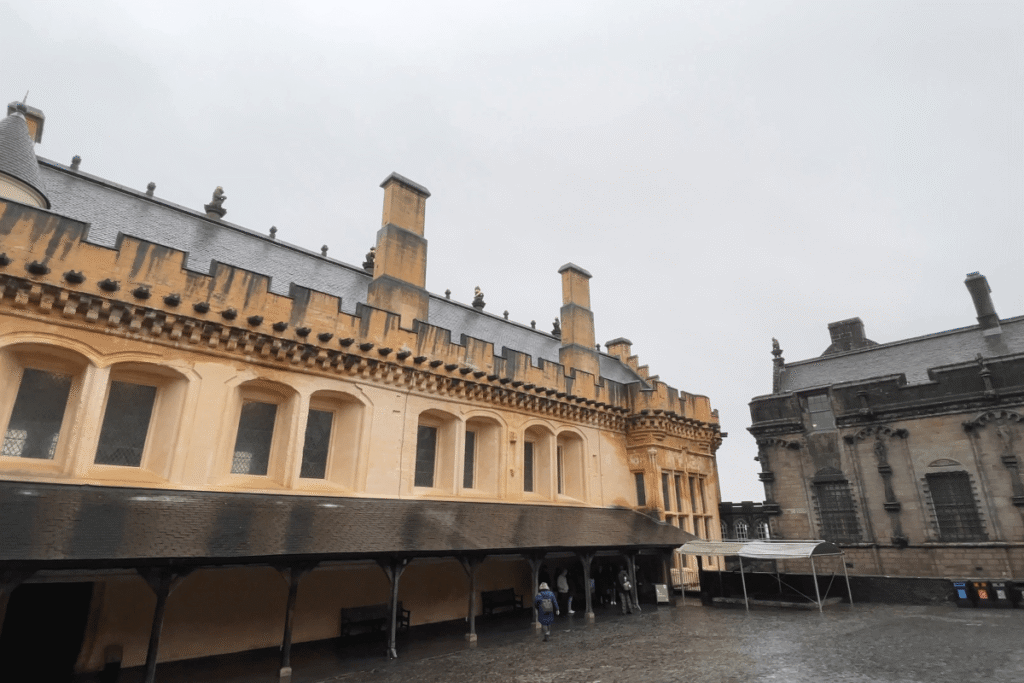
Whispers in the Stone – The Green Lady
Any castle with centuries of history will gather its share of ghost stories, and Stirling is no exception. The best known is the Green Lady, a figure dressed in a voluminous green gown who appears to people before a disaster. There are multiple versions of her story – some say she was a servant who died trying to save Mary, Queen of Scots, in a fire; others see her as a spirit older than the castle, bound up in the land itself. Soldiers on guard duty and night watchmen have claimed to see the sound of footsteps on empty corridors, sudden chills, and doors opening and slamming of their own accord. Skeptics shrug their shoulders, but believers point to the Green Lady as part of Stirling’s intangible magic. She’s a reminder that history is not only about what we see, but what we feel too.
A Living Symbol of Scotland
Through siege and ceremony, triumph and neglect, Stirling Castle remains a living symbol of Scotland’s history and resilience. It’s a place where the story of a nation has been written in stone, and where visitors can still trace the footsteps of warriors, monarchs, and maybe even ghosts. Standing on the battlements with the wind in your face and the Forth sparkling below, you can almost hear the distant pipes, the clash of steel, and the whispered prayers of those who once guarded Scotland’s future.

Architecture, Design & Art
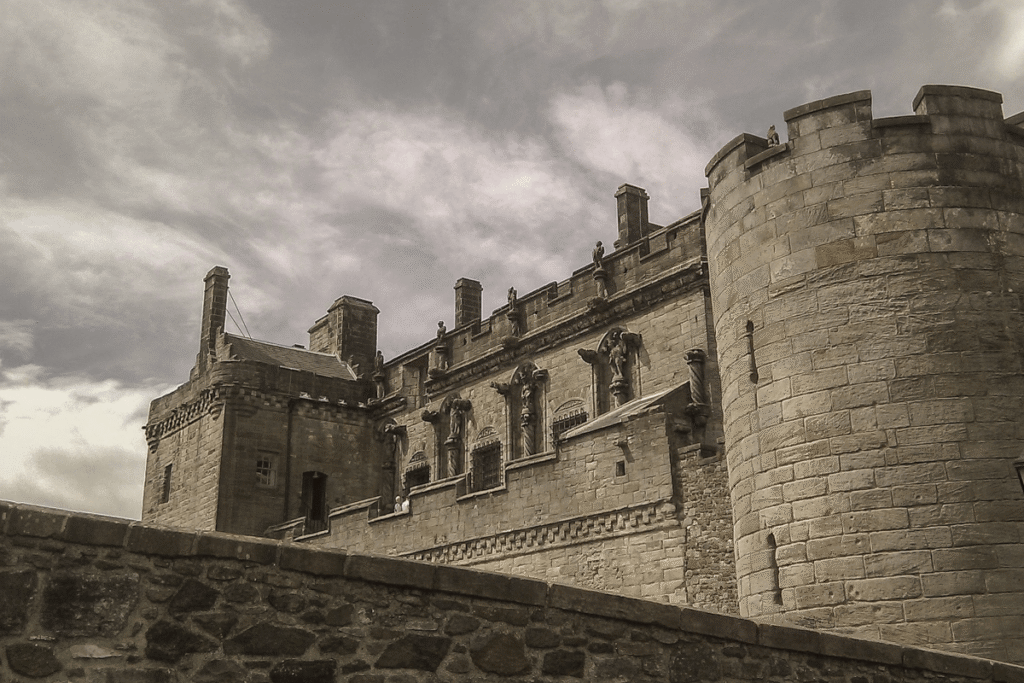
The Outer Defenses and the First Impression
From the town below, the approach to Stirling Castle is a gradual unveiling. The uneven paving of Broad Street eventually gives way to the castle walls, which rise up around you – stark, white, and looming. The curtain walls themselves were a product of 18th-century military upgrades, designed to be as intimidating as they were defensive. Look for the protruding artillery bastions, angled to allow cannon fire to sweep the slopes below. The most famous of these is the French Spur, a star-shaped fortification added in the 16th century in response to the threat of heavy artillery.
Passing through the main gate is a moment of crossing into another world. The cobbles ring differently underfoot, and the air has the chill of being in the long shadow of the walls. There are the barracks buildings to your left, a reminder that this was once a working garrison, but it’s the path leading to the right, curving up and into the castle heart, which draws your attention.
The Outer and Inner Close
The design of Stirling’s defences and buildings is tiered, with multiple “closes” or courtyards, each fulfilling its own purpose. The Outer Close was the traditional service area for the castle – where supplies and materials would arrive, where soldiers were readied for battle or simply mustered, and where craftsmen would ply their trade. Pass through the Forework, the outer gate built by James IV, complete with its own foreboding gatehouse, and you enter the Inner Close. In the Inner Close, the most important buildings are arrayed before each other, like actors on a stage waiting for their cue.
The Great Hall
Occupying one side of the Inner Close is the Great Hall. This late medieval construction was built by James IV in around 1503. The hall itself is the largest in Scotland of its type, with the surviving interior over 42 metres long and 14 metres high. From the outside, the pale surface of “King’s Gold” limewash shines dazzlingly in the sun, a deliberate policy of impressing visitors from afar. Passing inside, however, the eye is naturally drawn upward towards the hammer-beam roof, a tracery of oak woodwork held in place by metal joints, which seem to levitate over the hall. Light pours in through tall windows and from the high roof lantern, and the furniture is sparse and unadorned. We can imagine this same space full of the flickering light of hundreds of candles during a royal feast, the air perfumed with roasting meat and the sound of harp strings and laughter. The Great Hall is one of Stirling Castle’s most theatrical spaces, a place where power and artifice mingle and where politics and pageantry are indistinguishable.
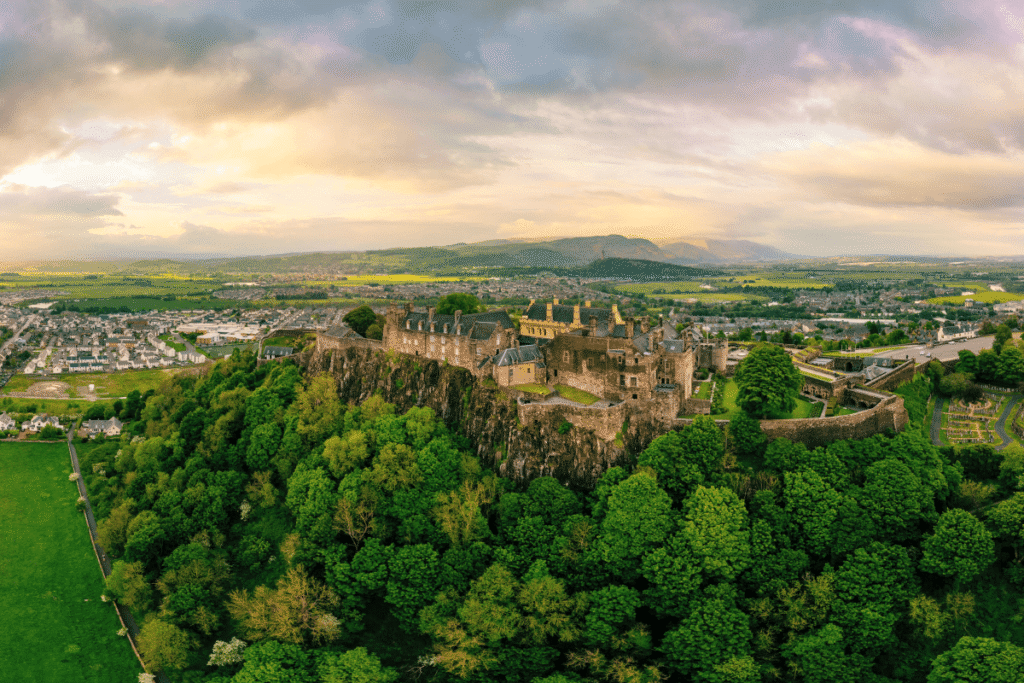
The Royal Palace
Opposite the Great Hall is the Royal Palace, the star of Stirling’s Renaissance transformation. Commissioned by James V, the Palace’s exterior is both a masterpiece of craft and a piece of propaganda. The stonework walls are studded with carved figures in stone – warriors and saints and allegorical figures, a carefully chosen pantheon created to demonstrate the king’s moral right to rule.
The interiors of the palace have been laboriously restored to their 16th-century state. The ceilings are painted in vibrant hues: deep blues, reds, and ochres, flecked with gold leaf, catching the sun. The walls are hung with reproductions of the “Hunt of the Unicorn” tapestries, which have been woven by a dedicated team of modern artisans using period techniques. Floors of polished woodboards creak softly as visitors pass between chambers with individual themes and names – King’s Presence Chamber, Queen’s Inner Hall – spaces where the business of state and royal life mixed with ceremony and everyday life.
The Stirling Heads
A further extraordinary feature of the palace is a gallery of Stirling Heads: carved oak medallions, about a metre across, with portraits of an array of faces. Kings and queens, classical heroes, and mythical figures stare down from the ceiling with a mixture of pride and curiosity. Created in the 1540s, these are masterpieces of Renaissance portraiture. Today, many painstakingly recreated heads hang in the restored palace rooms, while a dedicated gallery displays many of the fragile originals.
The Chapel Royal
To one side of the Inner Close, the Chapel Royal stands at the end of its courtyard. Completed in 1594 for the baptism of Prince Henry, son of James VI, the chapel’s exterior gives little hint of the airy, decorative space within. Painted friezes greet visitors, and the room itself is more like a ceremonial hall than a church, with its light and bright spaces. Today, the chapel is still used for services and events, and the acoustics are clear and resonant, a testament to its continuing life as a place of music.
Gardens & The Esplanade
Outside the main complex, the Esplanade is a broad stretch of open ground on the flat section before the castle’s main entrance. It was originally a military parade ground, but in recent years it has become a space for re-enactments, concerts, and events under the summer sun. Outside the walls, too, you’ll find the Queen Anne Garden, a space of neatly trimmed lawn and flowerbeds that softens the fortress lines of the castle. The history of the garden stretches back at least to the 15th century, and it is easy to imagine royal ladies strolling here, heads thrown back and hands clasped behind their backs, but eyes alert to the distant hills.
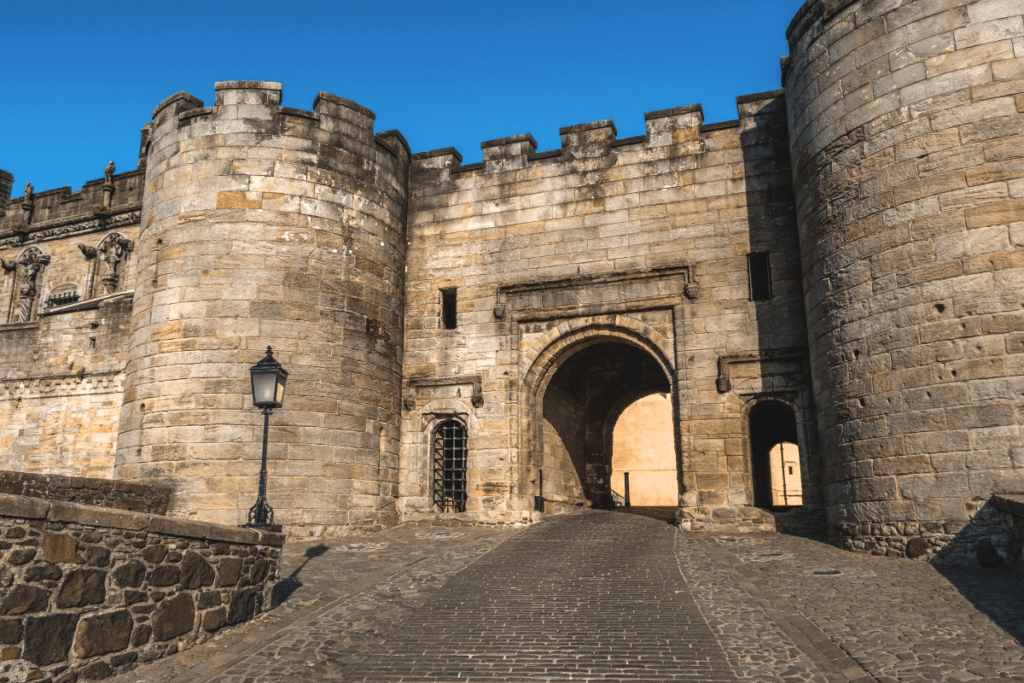
Restoration & Craftsmanship
Today, visitors see Stirling Castle in a state that is close to how it would have been during its Renaissance peak. The restoration of the castle, completed in 2011, was an ambitious undertaking. Historians and artisans worked together to source authentic materials, replicate period techniques, and even revive lost colorways. Limewash was mixed to a historical recipe to exactly match the 16th-century shade; tapestries were recreated and handwoven in workshops that were open to the public; stone carvers had to study ancient chiseling marks before setting their hands on the palace façades.
The result is a place that is more than a museum – an immersive environment where the gap between past and present seems to blur. It is easy, as you wander around the courtyards, through the halls and chambers, to forget the centuries in between, and see Stirling Castle not as a ruin, but as a vibrant and living seat of power and art.

Visiting Stirling Castle
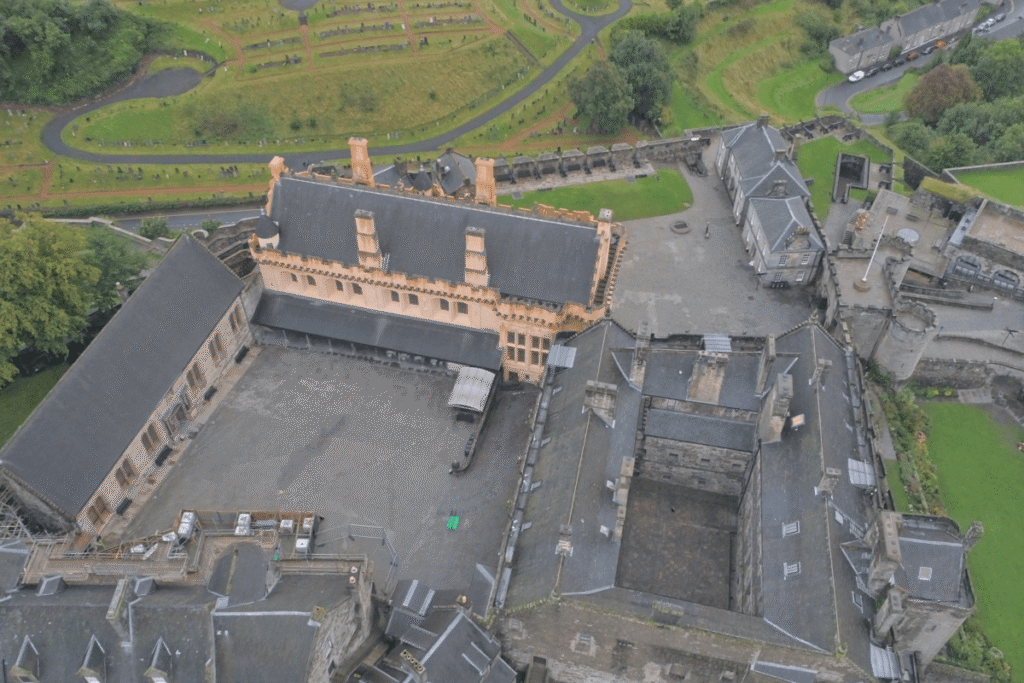
The walk up to Stirling Castle has a curious way of slowing you down. You start out briskly on the cobbled streets of the Old Town, but as the paths twist uphill the walls loom higher and higher until you find yourself on the esplanade gazing at a fortress that has dominated this part of Scotland for centuries. Inside there’s so much to see that a visit is best planned. But don’t make it a military operation. Here’s how to take your time and enjoy everything.
Getting There & Getting In
Arriving at Stirling Castle is one of the easiest parts of the day. If you’re coming from Edinburgh, there’s a direct train that takes under an hour through lush green fields and pretty, postcard villages you’ll be sorry you didn’t pack a picnic for. Glasgow is even closer: about 35 minutes and worth fighting your neighbour for a window seat as the train slides into Stirling.
From Stirling Station you have a few options. Feeling energetic? The 15–20 minute walk up through the Old Town is a delight in its own right. The route is an easy ascent past grand old buildings, cafés and an occasional busker or two. If the walk up the hill looks steep–or you’re going to save your energy for exploring inside–it’s no problem at all. Local buses and taxis will be waiting outside the station to whisk you up to the castle top.
If you’re driving, Stirling Castle is just off the M9 so it’s an easy trip from either Edinburgh or Glasgow. There’s parking by the esplanade, but on summer weekends it can fill up fast. In that case, you can park in the city centre and catch a bus or take the scenic route up through the Old Town.
Tickets & Tours
First thing to know about Stirling Castle: buy your ticket online. Yes, it’s a faff of clicking and remembering passwords, but it’s worth it. You’ll save a couple of pounds on the adult ticket (online vs at the gate) and dodge the ticket queue to be first in the door. Adult tickets in 2025 are £18.50 online with reduced rates for children, concessions and family tickets. The gate price is a couple of pounds higher. Check the official website for the most up-to-date visiting information.
Once you’re in you need to decide whether to join one of the short guided talks. They’re free, friendly and full of those ‘I didn’t know that!’ facts that bring the place alive. Or you can just wander on your own and let the castle show you at your own pace. Either way, be sure to pay attention to the costumed interpreters in the Royal Palace. They’re not just for kids–ask them about their clothes or life in the castle and you’ll get stories richer than any guidebook.
When to Visit
The best time of day for Stirling Castle depends on you. If you’re a morning person, consider arriving as soon as the doors open. You’ll have the place almost to yourself, the light is soft and the air is fresh. You’ll have space to stand in the Inner Close, take in the palace façade, and imagine life a few centuries ago.
Late afternoons are another good time–especially in the summer, when the light is magical and most of the big groups have gone home. There’s something special about seeing the shadows creep across the walls of the Great Hall as the day draws to a close.
Stirling Castle is open year round, and each season has its benefits. Spring is my favourite for the gardens in flower and a pleasantly mild climate. Summer is busy, with lots of events, but the days are long and there’s time for a wander round afterwards. Autumn is beautiful too, crisp air, fewer visitors, and everything takes on a golden glow. Winter is quieter still, and if you’re lucky enough to catch snow on the surrounding hills the view from the battlements is unforgettable.
Accessibility & Visitor Tips
Perched up on a steep hill, Stirling Castle might seem daunting at first. But once you’re in it’s more accessible than you might expect. A mobility vehicle runs from the esplanade up to the main complex, and lifts will take you up to most of the key areas including the Royal Palace. The paths are cobbled and not the easiest for wheelchairs and prams, but the staff are helpful and will advise you on the best routes to take.
A few tips to make your visit even better:
- Stop and look at the view on the walls before you go in. The vista over the River Forth, the Wallace Monument and the Ochil Hills is spectacular and free of the crowds that gather inside.
- Take the long way around. Most visitors head straight for the Great Hall and Royal Palace. But if you start with the kitchens or the outer defences you’ll miss the crowds and circle back later when it’s quieter.
- Bring a camera, but leave time to put it down. The best light for photos is golden morning light on the palace façade, and moody late afternoon light for the sky and battlements. But don’t spend your whole visit behind a camera–there’s atmosphere in this place you can’t capture.
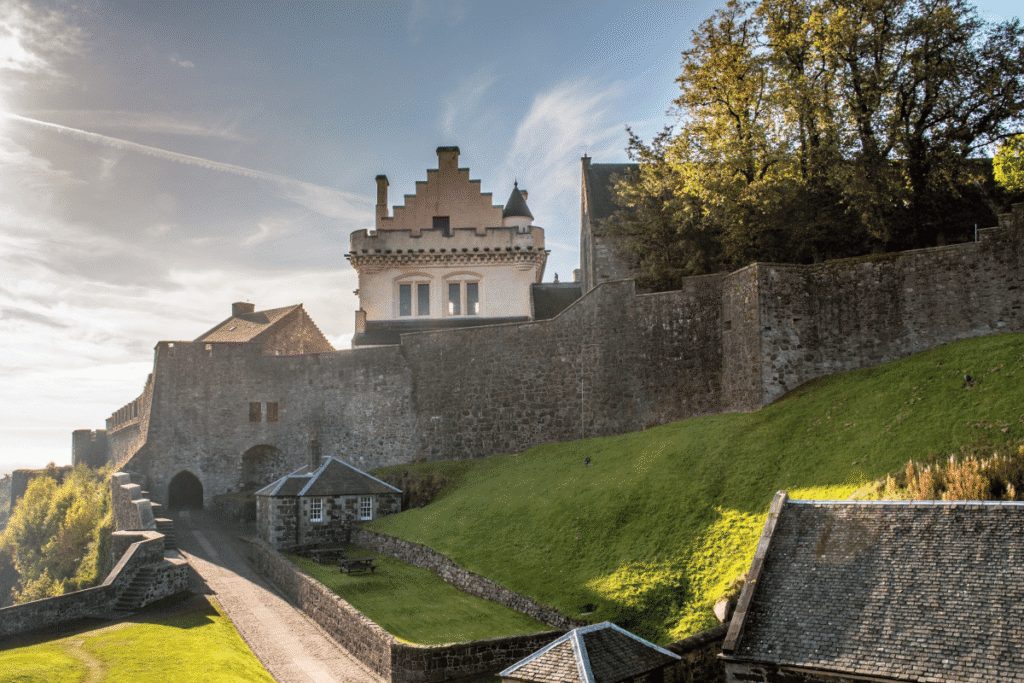
Plan Your Visit
Don’t worry about a rigid itinerary. Instead, think of your visit as a gentle loop that you can circle a few times if you have the time. Start by pausing on the walls to take in the view, then wander down into the Outer Close where soldiers once drilled and goods were unloaded from the river. Let the Great Hall draw you in next. Stand in the middle and imagine it on a feast day: the long tables heaving with food, the air warm from the hearth fires, the king’s voice booming out from the dais.
Step inside the Royal Palace next, and slow down. These rooms are full of life after their recent restoration in vibrant colours, tapestries, painted ceilings and the carved Stirling Heads that leer down from above. You’ll want to linger in each room, taking in the fine brushstrokes of the wall paintings, the intricate pattern of the carved decoration, the mischievous faces on the carved heads.
The Chapel Royal is a short walk through the gardens. It’s a bright and airy space that’s witnessed coronations, baptisms and royal ceremonies. Even if you’re not religious it’s a good place to take a moment of quiet before wandering out into the gardens and along the ramparts for one last look at the city.
Loop back to the café near the entrance for a coffee or slice of cake before you leave. On a sunny day, you can get a seat by the window. On a rainy day it’s the perfect place to warm up and watch the world go by on the esplanade through a window as the rain taps on the glass.
Do Your Own Thing
The great thing about Stirling Castle is that there’s no single way to visit. History buffs can spend hours in the exhibitions, architecture lovers will geek out on the Renaissance detailing, and families can make the whole day an adventure with treasure-hunt booklets and interactive displays.
Whichever of you is coming, I recommend giving yourself time to linger. Peer into the carvings, poke your head through the arrow slits, feel the wind on the battlements. Stirling Castle is a place where history still whispers in the corners if you just take time to listen.

Nearby Attractions

Explore more than just Stirling Castle. In fact, with so much history and culture packed into such a small city, some of the best sites are a stone’s throw from the castle. If you’ve got the time (and the legs) here are some that you won’t want to miss!
The National Wallace Monument (2 mi / 3.2 km)
Situated at the base of the castle’s southeast ramparts is this towering Gothic monument to William Wallace, the heroic warrior who fought for Scottish independence in the 13th century. Built in the 19th century, the National Wallace Monument is a monument in more ways than one, with 246 steps to climb before reaching the top, known as the Crown. Views from here are panoramic, with stunning vistas of the Ochil Hills and Forth Valley. Inside you can find out about the story of Wallace’s life, and there’s plenty to see and do, including the “Wallace Sword” (supposedly the one Wallace used to fight at Bannockburn). For the best views take advantage of a clear day.
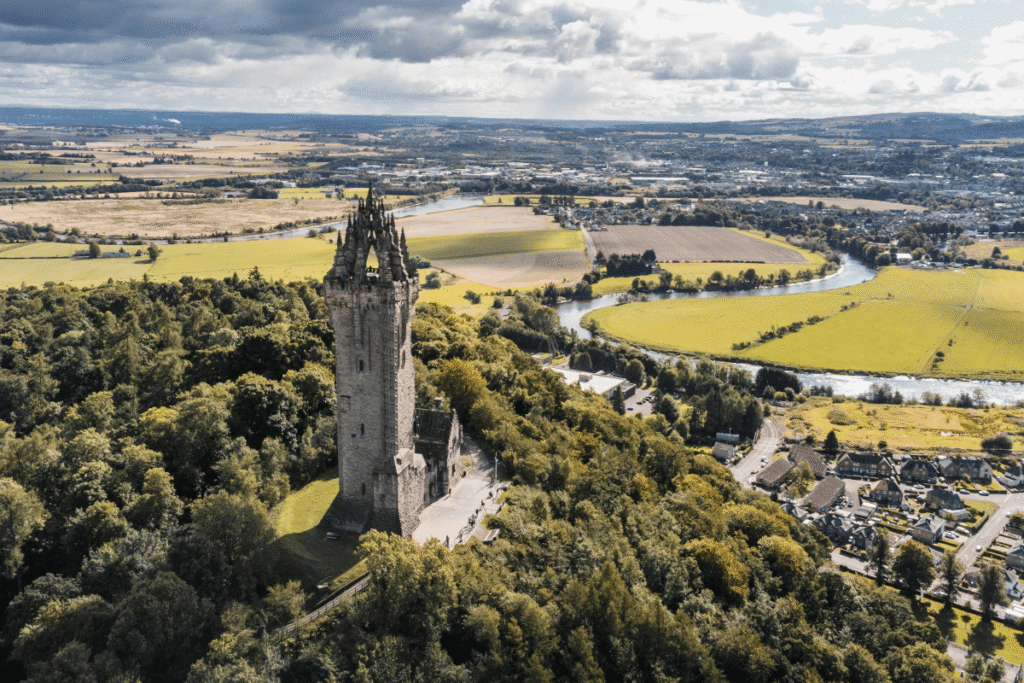
The Battle of Bannockburn Visitor Centre (2.5 mi / 4 km)
Drive a few miles south to this state-of-the-art visitor centre to learn about the 1314 battle between the Scottish army of Robert the Bruce and the English. Using the latest 3D technology, Battle of Bannockburn offers visitors the chance to put themselves in the heart of the action and “experience” the battle. You can take on the role of a medieval commander, and test your leadership skills against the other. It’s also a great opportunity to explore the historic battlefield and see where the fate of Scotland was decided.
Old Town Jail (5-min walk)
Head down into the Old Town for a taste of something grittier than normal. The Old Town Jail is not your average jail. Costumed guides bring to life the grim history of a Victorian prison with a side order of black comedy (pun intended). If you think it ends there, a visit to the rooftop observation tower (you guessed it, the Gallows) will reward you with one of the best views of Stirling’s town centre—and a very different perspective of the castle walls.
Cambuskenneth Abbey (1 mi / 1.6 km)
Cross the River Forth to find the ruins of a 12th-century Augustinian abbey. The peaceful, scenic setting is as impressive as the abbey itself, with rolling meadows leading down to the banks of the river. Cambuskenneth is where James III and his queen, Margaret of Denmark, are buried, and it is a great place to relax and unwind after a visit to the busier castle.
King’s Knot & Royal Gardens (10-min walk)
At the foot of the hill below the castle sits the King’s Knot, an elongated 17th-century landscaped earthwork which was once part of the royal gardens. Also known as the “cup and saucer” the design is unusual and doesn’t really reveal itself until you are up above looking down on it. Head up to the castle ramparts for the best views.
Bonus for families: The Engine Shed (15-min walk)
Historic Environment Scotland’s hands-on building conservation centre, The Engine Shed, has interactive exhibits to keep both kids and adults entertained. Entry is free.
From bloody battlefields to tranquil riverside ruins, these locations bring different facets of Stirling’s part in Scotland’s history to life and, with the exception of the Battle of Bannockburn Visitor Centre, they can all be conveniently explored in a day with the castle.

FAQ – Visiting Stirling Castle
How old is Stirling Castle?
The earliest written records date to the 12th century, but the site has likely been fortified since the early medieval period. Most of what you see today was built between the 15th and 17th centuries.
Is Stirling Castle worth visiting over Edinburgh Castle?
They’re very different experiences. Edinburgh Castle dominates a bustling capital; Stirling feels more self-contained, with immersive Renaissance interiors and sweeping countryside views. If you can, see both—but Stirling is often less crowded and easier to explore in full.
Can you see battlefields from the castle?
Yes. From the walls you can spot the sites of the Battle of Stirling Bridge (1297) and the Battle of Bannockburn (1314), both pivotal moments in Scotland’s Wars of Independence.
Are there ghosts at Stirling Castle?
The most famous is the Green Lady, said to appear before disaster strikes. Whether you believe the stories or not, night guards and guides have reported mysterious footsteps and sudden chills.
How long should I plan for a visit?
At least 2.5 hours to see the highlights, and up to half a day if you want to linger in every exhibition, catch a guided talk, and enjoy the gardens.
Is the castle family-friendly?
Very. Kids can pick up activity booklets at the entrance, explore interactive exhibits, and chat with costumed interpreters who bring history to life.
Can I take photos inside?
Photography is allowed in most areas, but tripods are generally not permitted without prior permission. The interiors, especially the Royal Palace, photograph beautifully—just watch the lighting.
Is Stirling Castle accessible for wheelchairs?
Yes, with some limitations. A mobility vehicle operates between the esplanade and main buildings, and there are lifts to most areas. Cobblestones and gradients can be tricky, so allow extra time.
Is it free with Historic Environment Scotland membership?
Yes. Members get free entry along with other benefits at Historic Scotland sites.
Does the castle host events?
Yes—everything from living-history weekends and seasonal markets to open-air concerts in summer. Check the official website before visiting; these can be highlights of the year.
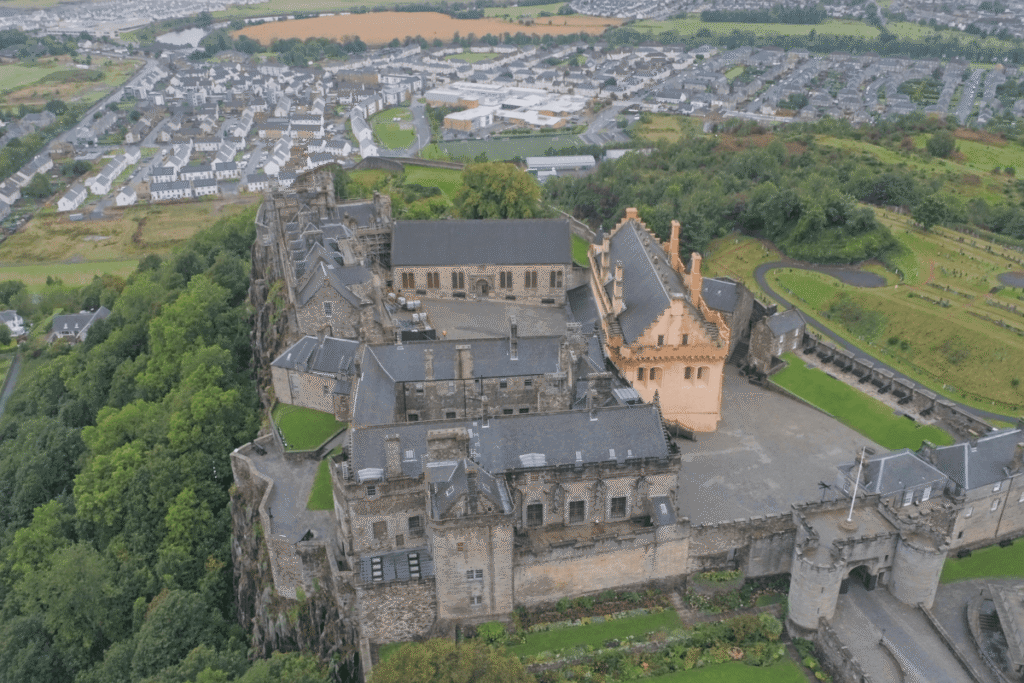

Final Thoughts
Stirling Castle is one of those sites that you don’t visit just as part of a Scotland road trip but because you know you can almost reach out and touch Scottish history. Peer down from its battlements over the fields and town where battles were fought that shaped Scotland and walk around its palace buildings where kings, queens and foreign envoys have trod the floors of its palatial rooms for the past five centuries. It even thrums with a constant background noise of life as it sits in silent but imposing stateliness, remembering feasts, coronations and sieges past.
Stirling is also one of those sites that has such a high concentration of all of the things you look for in castles. Whether you love it for the history, architecture, great views, ghost stories—or just a thirst for the curmudgeonly remains of old, broken Britain—the Royal Palace still shines in Renaissance finery, the Great Hall still impresses as you would expect from its size and location and views from the castle’s highest points will leave you gobsmacked as they do for every castle after a while. Either way, Stirling Castle is a truly immersive experience and one of those places that makes you feel like you’ve truly stepped into another world.
💬 If you’ve already visit Stirling Castle or other Scottish castles, we want to hear all about it! What was your favourite moment at Stirling Castle? Drop a comment below with your stories and tips. Or tag us on Instagram @CastleQuestChronicles!
👉 And if you want more castle adventures, check out these guides on “Edinburgh Castle: A Comprehensive Guide to Scotland’s Historic Fortress” and on the “10 Best Castles to Visit in Scotland”.
🏰✨Thanks for reading. If you found this article interesting, be sure to follow us along. We are also on Instagram, Facebook, Pinterest, YouTube, TikTok, and X. You can also see all our castle stories here! More castles (and more stories) are on the way.

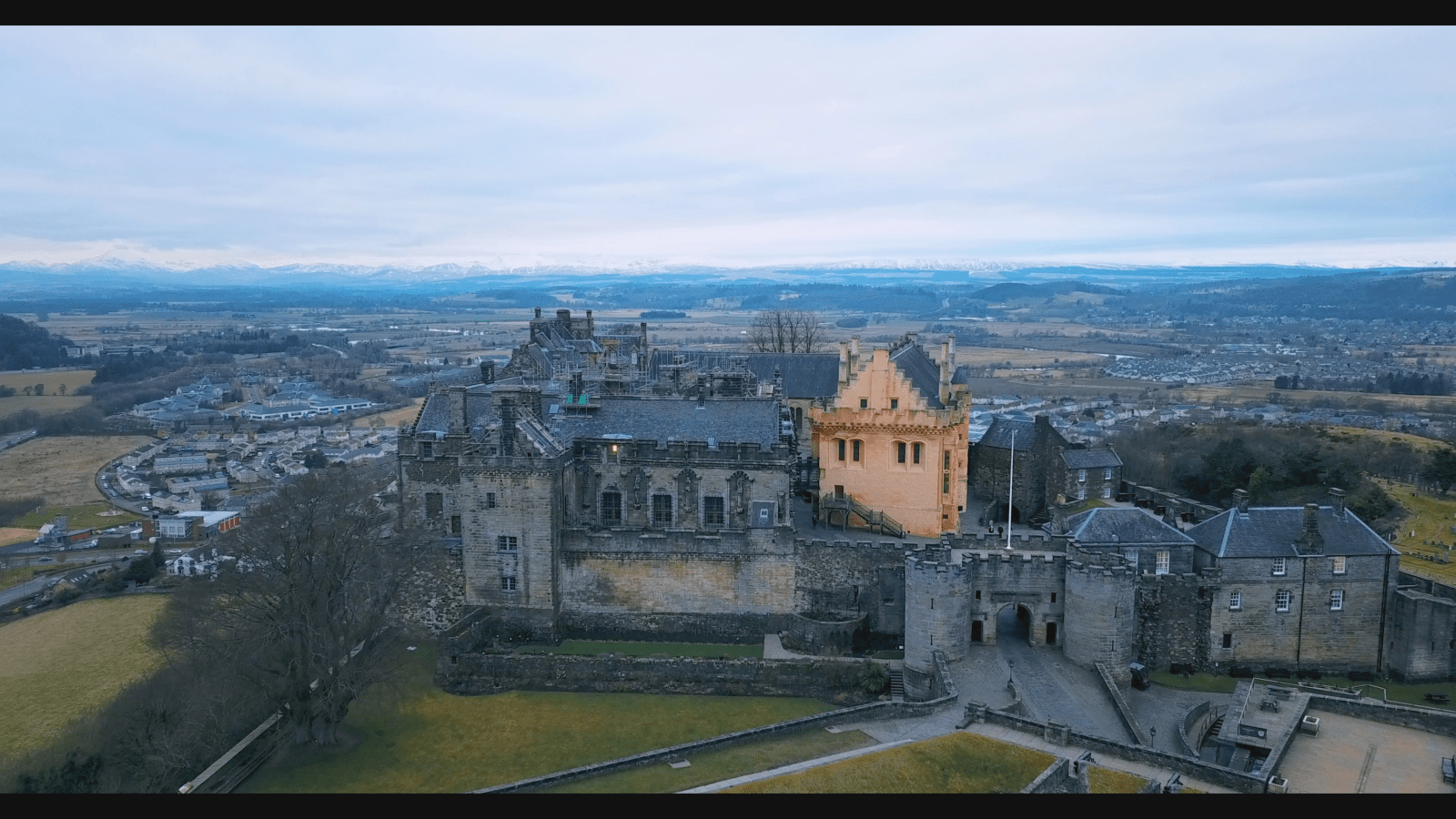

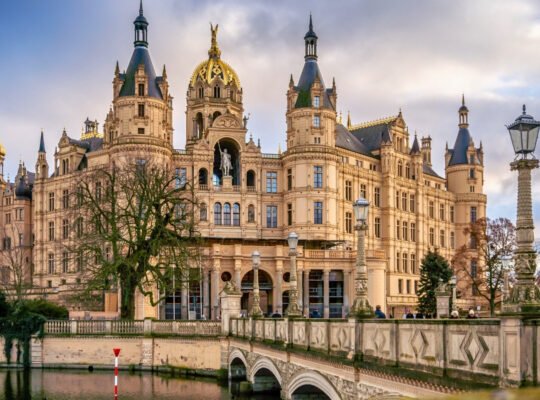

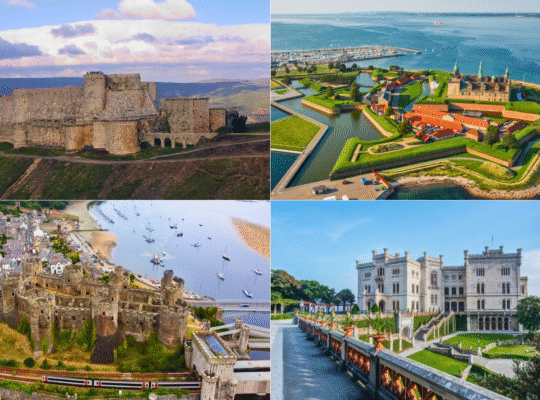
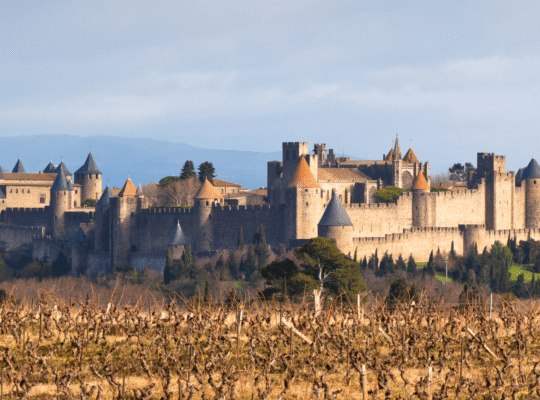
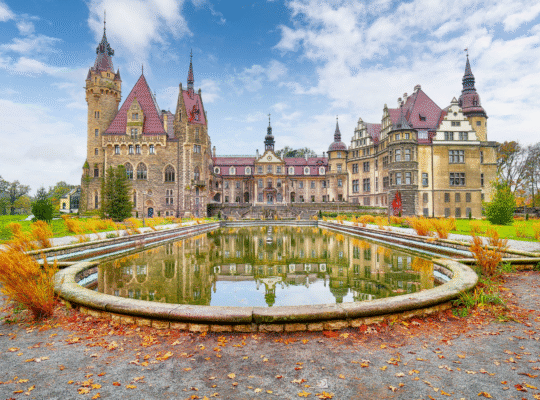
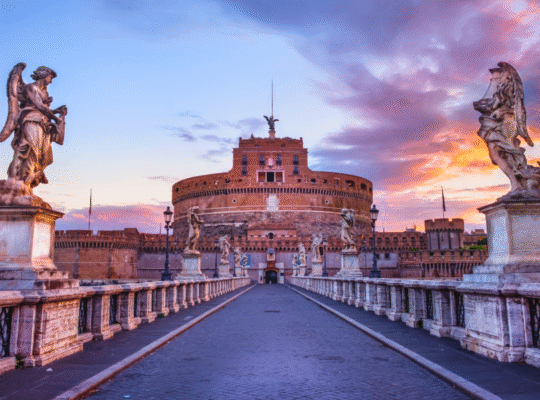

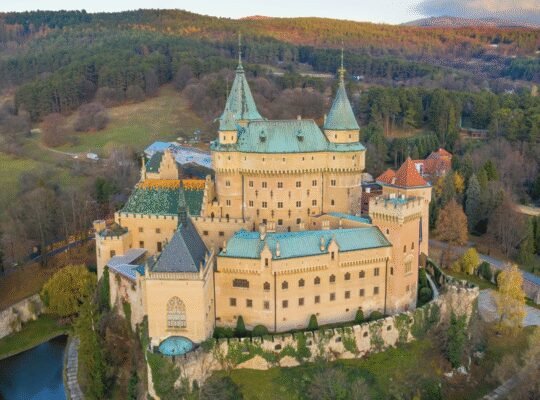
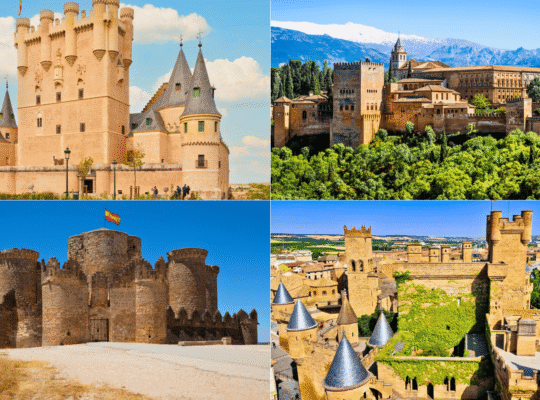
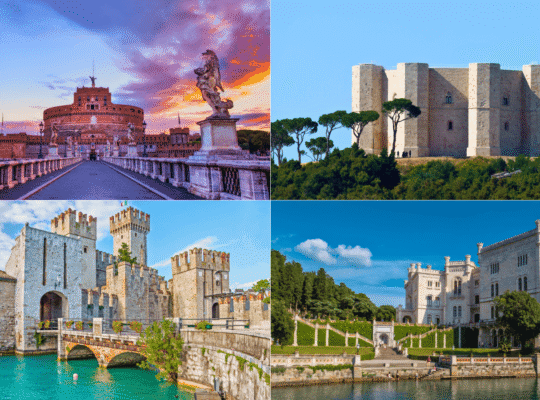
2 Comments